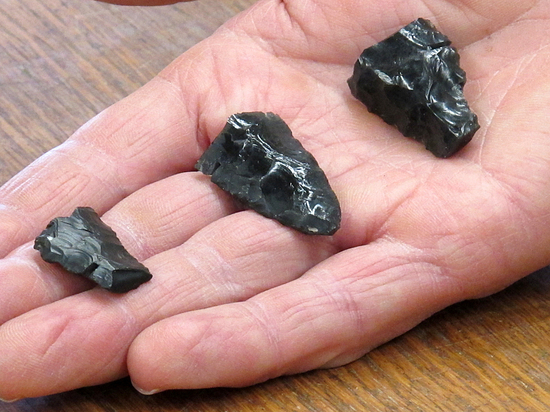The Clovis Weren’t the First Americans
Projectile points found in Oregon provide more evidence that people arrived in the New World before the Clovis culture

Some of the Western Stemmed projectile points found in Oregon’s Paisley Cave. Image: Jim Barlow
A hundred years ago, archaeologists thought Native Americans came to North America only 5,000 years ago. That belief changed in the 1920s and 1930s as researchers started finding stone projectile points associated with the fossils of mammoths and giant bisons—animals that went extinct more than 10,000 years ago. For decades, the oldest known points dated to 13,000 years ago. Called Clovis points, they contained characteristic “flutes,” or long, concave grooves, where a spear locked into place.
More recent evidence reveals humans reached the New World, via the Bering Strait, by at least 15,000 years ago. These early Americans weren’t making Clovis points. Last week, archaeologists announced in Science another example of pre-Clovis technology.
The tools come from Oregon’s Paisley Caves. Dennis Jenkins of the University of Oregon and colleagues determined people were living in the area by at least 14,000 years ago based on the radiocarbon dates of human coprolites (fossilized dung) found in the cave. They also found projectile points of the same age or slightly older than Clovis points. Known as the Western Stemmed Tradition, these points are narrower, lack flutes and require a different chipping method to make than Clovis points.
The team suggests the Clovis and Western Stemmed points probably developed independently from an even earlier tool technology, with the Clovis originating in the Plains and Southeast and the Western Stemmed arising in the West. This fits with a discovery reported last year in Science. At the Debra L. Friedkin site in central Texas, archaeologists recovered more than 16,000 artifacts dating to 13,200 to 15,500 years ago. Among the artifacts were blades and two-sided flakes that Clovis tools could have evolved from, the researchers suggested. (A study published online in the Journal of Archaeological Science, however, challenges those dates and even argues that the artifacts may actually be Clovis tools.)
In other early American news, a team led by David Reich of Harvard Medical School reconstructed the ancestry of Native Americans living in North and South America. They reported their findings last week in Nature. Based on a genetic analysis of 52 modern Native American groups and 17 Siberian groups, the researchers concluded the majority of Native Americans descend from a single Siberian population. Arctic people who speak Eskimo-Aleut languages also inherited about half of their genetic material from a second wave of Siberian immigrants. Members of a third migration contributed to the gene pool of Na-Dene-speaking Chipewyans of Canada. Finding multiple migrations complements previous genetic, archaeological and linguistic studies.
Of course, that doesn’t mean there were only three migrations to the New World. The researchers only looked at the ancestry of living Native Americans. There could be early migrating groups that didn’t leave behind living descendants. That’s something we may never know.
/https://tf-cmsv2-smithsonianmag-media.s3.amazonaws.com/accounts/headshot/science-erin-wyman-240.jpg)
/https://tf-cmsv2-smithsonianmag-media.s3.amazonaws.com/accounts/headshot/science-erin-wyman-240.jpg)